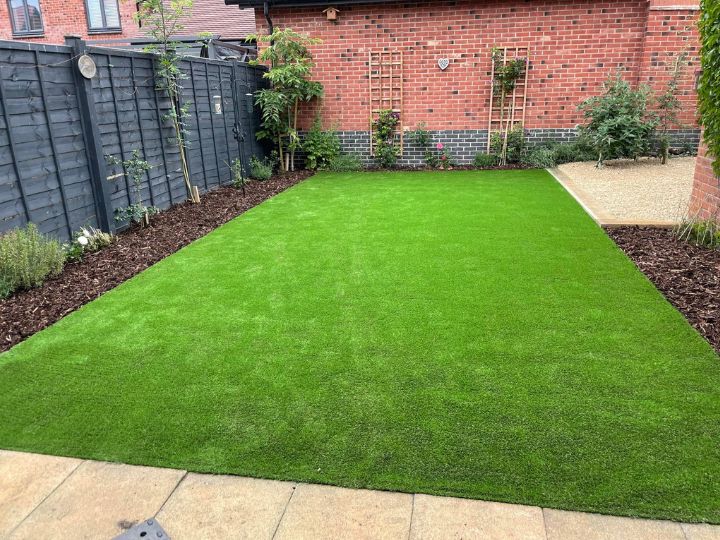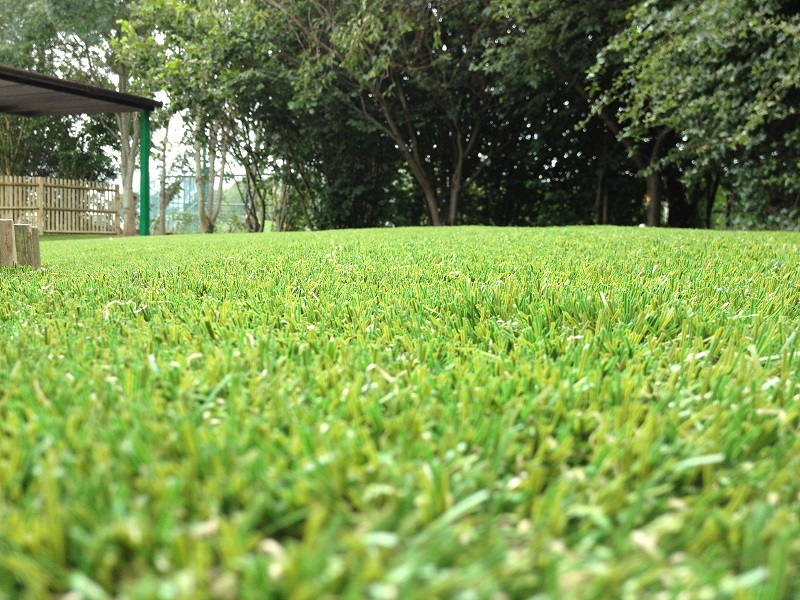Is natural turf really more environmentally friendly than artificial grass?

Published: 28 February 2024
Thanks for the contribution from Steve Barton, Always Green Artificial Lawns based in Kent.
If ever there was a product which could be described as Marmite, it's artificial grass, synthetic turf, astroturf, fake grass, or any other name it's commonly labelled as. You might love it or you might hate it, but it warrants a good look at whether synthetic turf really is as negative for the environment as some claim, while natural turf is widely assumed to be nothing other than environmentally positive.
 There is not much debate on the benefit of synthetic turf for sports, play and games projects as it allows continual and regular use, regardless of the weather conditions, with minimal maintenance. But what about home owners who are considering artificial grass for their gardens?
There is not much debate on the benefit of synthetic turf for sports, play and games projects as it allows continual and regular use, regardless of the weather conditions, with minimal maintenance. But what about home owners who are considering artificial grass for their gardens?- It's very low maintenance - this is an important advantage for some elderly and disabled people
- Year round use – artificial grass provides an excellent opportunity to keep kids active and outside all through the year. No mud being dragged into the house.
- It will always look like grass - some gardens simply will not produce a grass area worthy of the word 'lawn' because of excessive and continual shade or even pest infestation
- No water required – with artificial grass warm summer months don't produce a brown garden which is thirsty for great volumes of water
- No mowing required - this isn't just about being lazy it's also about avoiding electric or petrol mowing
- No pesticides or fungisides required – avoiding contamination of soil, water and vegetation
What are the some of the concerns with artificial grass?
.jpg)
- ‘Artificial grass is covering the planet' – this is nonsense. Artificial grass is selected by a relatively low number of people for one or some of the reasons listed above. Typically a significant national supplier of artificial grass may supply around 0.15 square miles of synthetic turf per year, much of which may be replacing existing artificial grass or being used in sports or playground projects
- ‘Artificial grass is a single use plastic’ – making the argument that an artificial lawn is the same as a plastic straw (which is used and discarded) is just untenable. Most lawns will be in place and used for 10-20 years so not single use
- ‘Artificial grass causes flooding’ - this is incorrect. The correct sub base is porous and the grass is manufactured with pre-punched holes to allow drainage into the sub base, and from there into the soil below
- ‘Artificial grass cannot be recycled’ – some artificial grass is donated for other projects, schools, dog shelters, charities, and so on. But it is fair to say that recycling of artificial grass has been limited until now, with developments in a couple ways:
- Many grasses are now available in fully recyclable materials
- We’re fast approaching a time where the UK provides specific facilities to recycle artificial grass.
Is natural turf production as environmentally friendly as most assume?
 Steve says, "With nearly 50 years of experience in the production of natural turf, the grass is not always greener on the other side compared to artificial grass. For many, there’s nothing like the smell of freshly cut grass, or how it looks when it’s at the ‘lush’ time of the year. Unfortunately it doesn’t always stay like that and homeowners and landscapers spend a good amount of time getting it looking just right. But… natural grass is not necessarily an eco-friendly lawn. Requiring water, pesticides, fertilisers, petrol and electricity to keep it in tip-top shape, it is not the ‘friend’ of the environment many believe it to be!"
Steve says, "With nearly 50 years of experience in the production of natural turf, the grass is not always greener on the other side compared to artificial grass. For many, there’s nothing like the smell of freshly cut grass, or how it looks when it’s at the ‘lush’ time of the year. Unfortunately it doesn’t always stay like that and homeowners and landscapers spend a good amount of time getting it looking just right. But… natural grass is not necessarily an eco-friendly lawn. Requiring water, pesticides, fertilisers, petrol and electricity to keep it in tip-top shape, it is not the ‘friend’ of the environment many believe it to be!"Turf production land
Turf production requires a vast acreage of grade 1-2 land taken out of food production, requiring us to import even more food products. The main turf growers in England exceed over tens of thousand acres.
Feritlizers and persticides

There are environmental concerns of combination fertilizers and pesticides. The herbicide, 2,4-D was formulated during World War II and became a very popular product because it effectively kills dandelions and clover. A side effect of killing these “weeds” is depriving the soil of nitrogen which they replenish. This means that by having only nitrogen-greedy grass growing, it is necessary to spread more synthetic fertilizer. Unfortunately, we also now know that 2,4-D is a toxic substance that has been used as a biochemical weapon in Agent Orange. There are many lawsuits ongoing and it’s a simple rule that any chemical manufactured to kill plants, insects, or animals is probably also toxic or hazardous to humans. A turf field is a monoculture, which means that it boasts only one type of plant. Monocultures are called a biological desert for a reason — they don’t support biodiversity or natural ecosystems because they have very limited habitat potential. Turf growers also spread Nitrogen, Phosphorous and potash on the growing turf. In areas of the country with free draining soils this run off then leaches into the waterways where it causes unrestrained algae growth, affecting water quality. Algae blooms block sunlight from reaching other aquatic organisms, deplete oxygen levels in the water, release harmful gases and even dangerous toxins. This creates dead zones in waterways killing fish by clogging or harming their gills, and raises the cost of treating drinking water. In humans it causes skin, eye, nose, or throat irritation, and even neurological symptoms. Most fertilisers are shipped to England having been mined abroad too!
Tractor and machinery use
 The use of tractors and cultivation equipment to produce the turf increase c02 emissions. For example, a modern 300 horsepower tractor operated for 40 hours per week would generate 2300 tonnes of CO2 per year - that’s just 1 tractor!
The use of tractors and cultivation equipment to produce the turf increase c02 emissions. For example, a modern 300 horsepower tractor operated for 40 hours per week would generate 2300 tonnes of CO2 per year - that’s just 1 tractor!
All regular farm fuels like diesel and LPG are fossil fuels. The use and burning of these fuels release stored up carbon in the form of CO2 and other GHGs and pollutants. Each litre of diesel burned results in the emission of around 2.6kg of CO2 to the atmosphere.
Water use
Vast amounts of water are taken out of rivers and dikes to water turf to keep it green in the dry spells we are now experiencing throughout the world. This has a knock on effect further down the landscape as water courses run dry due to excess water being taken out of the system to water turf, and its not just to keep it green and growing, water is also used to enable the crop to be cut when the ground is hard for economic reasons.
Many turf producers use a plastic netting when the seed is sown in order to be able to harvest the turf. This is meant to be biodegradable but years later it hasn’t degraded as it should
Some parts of the world are experiencing extreme weather fluctuations. Some of the main areas of turf production in this country are in areas that used to be under the sea hundreds of years ago. Turf production is harvested every 18 months now as opposed to 5-6 years, resulting in land to lay lower than flood levels, in fact we have ground that is 18inches lower than surrounding ground. Many of these areas are owned by the Crown Estates who had banned turf production due to environmental concerns"
 "So, like most things in life,there are good and bad points for both turf and artificial grass but once you have laid your new natural turfed lawn, all the above problems start again but on a smaller scale. Once artificial grass is laid there is little or no requirement to use water, pesticide, and so on, and many make allowances for bees and wildlife in other parts of the garden, including using ‘bug hotels’. There are recycling options now and these options will increase as time goes by. If you ever get the chance to have a walk around your local turf growers fields one of the first things you will notice is the lack of wildlife this is due to the constant spraying of fertilisers and continual mowing as often as every 3/4 days. There will be no bees as there are no natural pollinators in the sward and if you see any insects let me know because i never see any either. Our artificial grass does not go to landfill but to incinerator plants where it is burnt for electricity consumption and any waste from this process is used in concrete block and road production. So when we dispose of artificial grass we re- use any waste this generates. If, on the other hand, grass clippings are dumped into landfills, even using paper bags, the oxygen poor environment in the landfill increases the production of carbon-containing methane (greenhouse gas) which is worse for climate change than carbon dioxide"
"So, like most things in life,there are good and bad points for both turf and artificial grass but once you have laid your new natural turfed lawn, all the above problems start again but on a smaller scale. Once artificial grass is laid there is little or no requirement to use water, pesticide, and so on, and many make allowances for bees and wildlife in other parts of the garden, including using ‘bug hotels’. There are recycling options now and these options will increase as time goes by. If you ever get the chance to have a walk around your local turf growers fields one of the first things you will notice is the lack of wildlife this is due to the constant spraying of fertilisers and continual mowing as often as every 3/4 days. There will be no bees as there are no natural pollinators in the sward and if you see any insects let me know because i never see any either. Our artificial grass does not go to landfill but to incinerator plants where it is burnt for electricity consumption and any waste from this process is used in concrete block and road production. So when we dispose of artificial grass we re- use any waste this generates. If, on the other hand, grass clippings are dumped into landfills, even using paper bags, the oxygen poor environment in the landfill increases the production of carbon-containing methane (greenhouse gas) which is worse for climate change than carbon dioxide"More information or questions?
If you have any questions about artificial grass, how you can prepare your garden, how to install and care for your synthetic lawn please call us on 01825 729259 or email us


Comments
There are currently no comments, be the first to comment.